Skoria
| General Statistics | ||
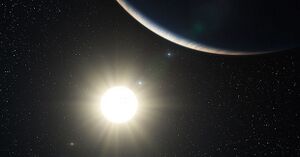 | ||
| Planetary Classification: | Class M | |
| Atmospheric Details: | Oxygen (15%), Nitrogen (15%), Noble & trace gases (70%). | |
| Planetary System Data: | Alakaram IIIa (Shayala) Class D) | |
| Alakaram IIIb (Nobas- towed from orbit) Class D ) | ||
| Gravity Notes: | Alakaram III (Skoria): 1.05 G | |
| Alakaram IIIa (Shayala): 0.46G | ||
| Alakaram IIIb (Nobas): 0.49G | ||
| Year and Day: | 235.955 standard days/23.25 standard hours | |
| Hydrosphere: | 71.5% | |
| Temperature Range: | -85°F Nighttime to 110°F Daytime | |
| Flora and Fauna: | Intense Flora with equally intense Fauna | |
| Resources: | Heavy Metals, Dilithium Cyrstals | |
Introduction[edit]
Skoria (pronounced Score-E-uh) is the third planet from Alakaram. It is the largest of the planets in the Alakaram System in diameter, mass and density.
Home to millions of species, including the Skorr, Skoria is the only one of four places in the galaxy know to harbor Sentient Avian life. Scientific evidence indicates that the planet formed 4.54 billion years ago, and life appeared on its surface within a billion years. Since then, Skoria's biosphere has significantly altered the atmosphere and other abiotic conditions on the planet, enabling the proliferation of aerobic organisms as well as the formation of the ozone layer which, together with Skoria's magnetic field, blocks harmful radiation, permitting life on land. The physical properties of the Skoria, as well as its geological history and orbit, allowed life to persist during this period. The world is expected to continue supporting life for another 1.5 billion years, after which the rising luminosity of Alakaram will eliminate the biosphere.
Skoria's outer surface is divided into several rigid segments, or tectonic plates, that gradually migrate across the surface over periods of many millions of years. About 71% of the surface is covered with salt-water oceans, the remainder consisting of continents and islands; liquid water, necessary for all known life, is abundant. Skoria's interior remains active, with a thick layer of relatively solid mantle, a liquid outer core that generates a magnetic field, and a solid iron inner core.
Skoria interacts with other objects in outer space, including it's primary star Skor and it's moon Shayala. At present, Skoria orbits Alakaram once for every roughly 235.955 times it rotates about its axis. This length of time is a sidereal year, which is equal to 235.95 solar days. Skoria's axis of rotation is tilted 23.4° away from the perpendicular to its orbital plane,producing seasonal variations on the planet's surface with a period of one tropical year (235.95 solar days). Skoria's only remaining natural satellite, Shayala, which began orbiting it about 4.53 billion years ago, provides ocean tides, stabilizes the axial tilt and gradually slows the planet's rotation. A cometary bombardment during the early history of the planet played a role in the formation of the oceans. Later, asteroid impacts caused significant changes to the surface environment. The other moon, Nobas, was in a feat of amazing engineering towed from Skoria's orbit after a terrible collision with a massive asteroid shifted the smaller moon's orbit and it threatened to destroy the planet.
Both the mineral resources of the planet, as well as the products of the biosphere, contribute resources that are used to support a global Skorr population. The inhabitants are grouped into 15 Mar'kaj districts, which interact through travel, and trade. Historically Skorr culture has developed many views of the planet, including personification as a deity and a modern perspective of the world as an integrated environment that requires stewardship. Skorr first left the planet in 2105, when Drola reached outer space.
Geographical Features
Weather and Climate
| Skoria | ||
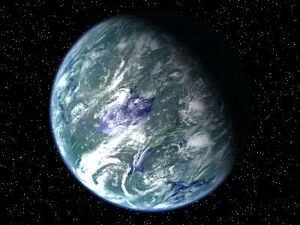 | ||
Skoria's atmosphere has no definite boundary, slowly becoming thinner and fading into outer space. Three-quarters of the atmosphere's mass is contained within the first 11 km of the planet's surface. This lowest layer is called the troposphere. Energy from the Sun heats this layer, and the surface below, causing expansion of the air. This lower density air then rises, and is replaced by cooler, higher density air. The result is atmospheric circulation that drives the weather and climate through redistribution of heat energy.
The primary atmospheric circulation bands consist of the trade winds in the equatorial region below 30° latitude and the westerlies in the mid-latitudes between 30° and 60°. Ocean currents are also important factors in determining climate, particularly the thermohaline circulation that distributes heat energy from the equatorial oceans to the polar regions.
Water vapor generated through surface evaporation is transported by circulatory patterns in the atmosphere. When atmospheric conditions permit an uplift of warm, humid air, this water condenses and settles to the surface as precipitation. Most of the water is then transported back to lower elevations by river systems, usually returning to the oceans or being deposited into lakes. This water cycle is a vital mechanism for supporting life on land, and is a primary factor in the erosion of surface features over geological periods. Precipitation patterns vary widely, ranging from several meters of water per year to less than a millimeter. Atmospheric circulation, topological features and temperature differences determine the average precipitation that falls in each region.
The Skoria can be sub-divided into specific latitudinal belts of approximately homogeneous climate. Ranging from the equator to the polar regions, these are the tropical (or equatorial), subtropical, temperate and polar climates. Climate can also be classified based on the temperature and precipitation, with the climate regions characterized by fairly uniform air masses. The commonly used climate classification system has five broad groups (humid tropics, arid, humid middle latitudes, continental and cold polar), which are further divided into more specific subtypes.
Skoria has a wide variety of terrain although a great deal is covered by massive, tightly-knit Pinok and Nosak forests. However, the planet also contains vast dry deserts and grassy plains and savannah , as well as oceans, secluded lakes, and mountain ranges which rise to several kilometers in height. The planet's low axial tilt and regular orbit ensures a comfortable climate. The climate is temperate and mild, with polar caps regulating the sea levels. Flora life included cambylictus trees and other large plants.
Hydrosphere
The abundance of water on Skoria's surface is a unique feature that distinguishes that planet from the others in the Alakaram System. The planet's hydrosphere consists chiefly of the oceans, but technically includes all water surfaces in the world, including inland seas, lakes, rivers, and underground waters down to a depth of 2,000 m. The deepest underwater location is in the Western Ocean with a depth of −10,911.4 m. The average depth of the oceans is 3,800 m, more than four times the average height of the continents.
The mass of the oceans is approximately 1.35×1018 metric tons, or about 1/4400 of the total mass of the planet, and occupies a volume of 1.386×109 km³. If all of the land on Skoria were spread evenly, water would rise to an altitude of more than 2.7 km. About 97.5% of the water is saline, while the remaining 2.5% is fresh water. The majority of the fresh water, about 68.7%, is currently in the form of ice.
About 3.5% of the total mass of the oceans consists of salt. Most of this salt was released from volcanic activity or extracted from cool, igneous rocks. The oceans are also a reservoir of dissolved atmospheric gases, which are essential for the survival of many aquatic life forms. Sea water has an important influence on the world's climate, with the oceans acting as a large heat reservoir. Shifts in the oceanic temperature distribution can cause significant weather shifts, such as the Northern-Southern Oscillation.
Atmosphere
The atmospheric pressure on the surface of the planet averages 101.325 k Pa, with a scale height of about 8.5 km. It is 78% nitrogen and 21% oxygen, with trace amounts of water vapor, carbon dioxide and other gaseous molecules. The height of the troposphere varies with latitude, ranging between 8 km at the poles to 17 km at the equator, with some variation due to weather and seasonal factors.
Skoria's biosphere has significantly altered its atmosphere. Oxygenic photosynthesis evolved 2.7 billion years ago, forming the primarily nitrogen-oxygen atmosphere that exists today. This change enabled the proliferation of aerobic organisms as well as the formation of the ozone layer which, together with planet's magnetic field, blocks ultraviolet solar radiation, permitting life on land. Other atmospheric functions important to life on Skoria include transporting water vapor, providing useful gases, causing small meteors to burn up before they strike the surface, and moderating temperature. This last phenomenon is known as the greenhouse effect: trace molecules within the atmosphere serve to capture thermal energy emitted from the ground, thereby raising the average temperature. Carbon dioxide, water vapor, methane and ozone are the primary greenhouse gases in the atmosphere. Without this heat-retention effect, the average surface temperature would be −18 °C and life would likely not exist.
Upper Atmosphere
Above the troposphere, the atmosphere is usually divided into the stratosphere, mesosphere, and thermosphere. Each of these layers has a different lapse rate, defining the rate of change in temperature with height. Beyond these, the exosphere thins out into the magnetosphere. This is where the planet's magnetic fields interact with the solar windAn important part of the atmosphere for life on Skoria is the ozone layer, a component of the stratosphere that partially shields the surface from ultraviolet light. The spacial transition line, defined as 100 km above the planet's surface, is a working definition for the boundary between atmosphere and space.
Due to thermal energy, some of the molecules at the outer edge of the planet's atmosphere have their velocity increased to the point where they can escape from the planet's gravity. This results in a slow but steady leakage of the atmosphere into space. Because unfixed hydrogen has a low molecular weight, it can achieve escape velocity more readily and it leaks into outer space at a greater rate than other gasses. The leakage of hydrogen into space is a contributing factor in pushing the planet from an initially reducing state to its current oxidizing one. Photosynthesis provided a source of free oxygen, but the loss of reducing agents such as hydrogen is believed to have been a necessary precondition for the widespread accumulation of oxygen in the atmosphere. Hence the ability of hydrogen to escape from the Skoria's atmosphere may have influenced the nature of life which developed on the planet. In the current, oxygen-rich atmosphere, most hydrogen is converted into water before it has an opportunity to escape. Instead, most of the hydrogen loss comes from the destruction of methane in the upper atmosphere.
Magnetic Field
The planet's magnetic field is shaped roughly as a magnetic dipole, with the poles currently located proximate to the planet's geographic poles. According to dynamo theory, the field is generated within the molten outer core region where heat creates convection motions of conducting materials, generating electric currents. These in turn produce the Skoria's magnetic field. The convection movements in the core are chaotic in nature, and periodically change alignment. This results in field reversals at irregular intervals averaging a few times every million years. The most recent reversal occurred approximately 700,000 years ago.
The field forms the magnetosphere, which deflects particles in the solar wind. The sun ward edge of the bow shock is located at about 13 times the radius of the planet. The collision between the magnetic field and the solar wind form the radiation belts, a pair of concentric, torus-shaped regions of energetic charged particles. When the plasma enters the atmosphere at the magnetic poles, it forms the aurora.
Orbit and Rotation
| View of Shayala from Skoria | ||
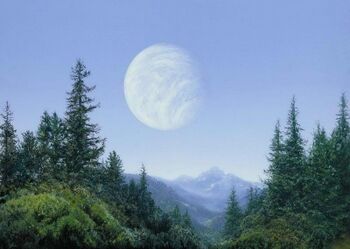 | ||
Rotation
Skoria's rotation period relative to it's Sun—its mean solar day—is 86,400 seconds of mean solar time.
Skoria's rotation period relative to the fixed stars, called its stellar day, is 86164.098903691 seconds of mean solar time (UT1), or 23h 56m 4.098903691s. Skoria's rotation period relative to the precessing or moving mean vernal equinox, named its sidereal day, is 86164.09053083288 seconds of mean solar time (23h 56m 4.09053083288s). Thus the sidereal day is shorter than the stellar day by about 8.4 ms.
Apart from meteors within the atmosphere and low-orbiting satellites, the main apparent motion of celestial bodies in the planet's sky is to the west at a rate of 15°/h = 15'/min. This is equivalent to an apparent diameter of Alakaram every two minutes.
Orbit
Skoria orbits Alakaram at an average distance of about 150 million kilometers every 365.2564 mean solar days, or one sidereal year. From Skoria, this gives an apparent movement of Skor eastward with respect to the stars at a rate of about 1°/day, or a Solar diameter every 12 hours. Because of this motion, on average it takes 24 hours—a solar day—for Skoria to complete a full rotation about its axis so that Alakaram returns to the meridian. The orbital speed of the planet averages about 30 km/s (108,000 km/h), which is fast enough to cover the planet's diameter (about 12,600 km) in seven minutes, and the distance to it's Moon (384,000 km) in four hours.
The Moon, Shayala, revolves with the planet around a common barycenter every 27.32 days relative to the background stars. When combined with the Skoria-Shayala system's common revolution around Alakaram, the period of the synodic month, from new moon to new moon, is 29.53 days. Viewed from the celestial north pole, the motion of Skoria, the Moon and their axial rotations are all counter-clockwise. Viewed from a vantage point above the north poles of both the Alakaram and Skoria, the latter appears to revolve in a counterclockwise direction about the prior. The orbital and axial planes are not precisely aligned: Skoria's axis is tilted some 23.5 degrees from the perpendicular to the Skoria–Alakaram plane, and the Skoria- Shayala plane is tilted about 5 degrees against the Skoria-Alakaram plane. Without this tilt, there would be an eclipse every two weeks, alternating between lunar eclipses and solar eclipses.
The gravitational sphere of influence, of the planet is about 1.5 Gm (or 1,500,000 kilometers) in radius. This is maximum distance at which the planet's gravitational influence is stronger than the more distant Sun or planets. Objects must orbit the Skoria within this radius, or they can become unbound by the gravitational perturbation of Alakaram.
Skoria, along with the Alakaram System, is situated in the Milky Way galaxy, orbiting about 28,000 light years from the center of the galaxy, and about 20 light years above the galaxy's equatorial plane spanning the border between the Alpha and the Beta Quadrant of the Orion spiral arm.
Axial Tilt and Seasons
Because of the axial tilt of the planet, the amount of sunlight reaching the surface varies over the course of the year. This results in seasonal change in climate, with summer in the northern hemisphere occurring when the north pole is pointing toward Alakaram, and winter taking place when the pole is pointed away. During the summer, the day lasts longer and Alakaram climbs higher in the sky. In winter, the climate becomes generally cooler and the days shorter. Above the arctic circle, an extreme case is reached where there is no daylight at all for part of the year—a polar night. In the southern hemisphere the situation is exactly reversed, with the south pole oriented opposite the direction of the north pole.
From space, the planet can be seen to go through phases similar to the phases it's Moon. By astronomical convention, the four seasons are determined by the solstices—the point in the orbit of maximum axial tilt toward or away from Alakaram—and the equinoxes, when the direction of the tilt and the direction to Alakaram are perpendicular.
The angle of the planet's tilt is relatively stable over long periods of time. However, the tilt does undergo nutation; a slight, irregular motion with a main period of 18.6 years. The orientation (rather than the angle) of Skoria's axis also changes over time, precessing around in a complete circle over each 25,800 year cycle; this precession is the reason for the difference between a sidereal year and a tropical year. Both of these motions are caused by the varying attraction of Alakaram and Shayala on the planet's equatorial bulge. From the perspective of Skoria, the poles also migrate a few meters across the surface. This polar motion has multiple, cyclical components, which collectively are termed quasi periodic motion. In addition to an annual component to this motion, there is a 14-month cycle called the Ald'ar wobble. The rotational velocity of the planet also varies in a phenomenon known as length of day variation.
Since the southern hemisphere is tilted toward Alakaram at about the same time that the planet reaches the closest approach to the Sun, the southern hemisphere receives slightly more energy from Alakaram than does the northern over the course of a year. However, this effect is much less significant than the total energy change due to the axial tilt, and most of the excess energy is absorbed by the higher proportion of water in the southern hemisphere.
History
Planetary History
Scientists have been able to reconstruct detailed information about the planet's past. About 4.54 billion years ago (within an uncertainty of 1%) Skoria and the other planets in the Solar System formed out of the solar nebula—a disk-shaped mass of dust and gas left over from the formation of the Sun. This assembly of the planet through accretion was largely completed within 10–20 million years. Initially molten, the outer layer of the planet Earth cooled to form a solid crust when water began accumulating in the atmosphere. The Moon was captured soon afterward, possibly as the result of an impact by a third planetoid sharing the same orbit as the young moon.
Out gassing and volcanic activity produced the primordial atmosphere. Condensing water vapor, augmented by ice and liquid water delivered by asteroids and the larger proto-planets, comets, and trans-orbital objects produced the oceans. The highly energetic chemistry is believed to have produced a self-replicating molecule around 4 billion years ago, and half a billion years later, the last common ancestor of all life existed.
The development of photosynthesis allowed the Sun's energy to be harvested directly by life forms; the resultant oxygen accumulated in the atmosphere and resulted in a layer of ozone (a form of molecular oxygen [O3]) in the upper atmosphere. The incorporation of smaller cells within larger ones resulted in the development of complex cells called eukaryotes. True multicellular organisms formed as cells within colonies became increasingly specialized. Aided by the absorption of harmful ultraviolet radiation by the ozone layer, life colonized the surface of planet.
Beginning with almost no dry land, the total amount of surface lying above the oceans has steadily increased. During the past two billion years, for example, the total size of the continents has doubled. As the surface continually reshaped itself, over hundreds of millions of years, continents formed and broke up. The continents migrated across the surface, occasionally combining to form a super continent. Roughly 750 million years ago , one the earliest known super continents, began to break apart. The continents later alternately recombined and broke apart in two consecutive cycles.
It has been hypothesized that severe glacial action between 750 and 580 mya, during the Pre-Skorr Age, covered much of the planet in a sheet of ice. This hypothesis has been termed "The Frozen Planet Theory", and is of particular interest because it preceded the biodiversity explosion, when multicellular life forms began to proliferate.
Following the Biodiversity explosion, about 535 mya, there have been five mass extinctions. The last extinction event was 65 mya, when a meteorite collision probably triggered the extinction of the majority of non-avian reptiles, but spared small animals such as mammals, which then resembled shrews. Over the past 65 million years, life has diversified, and several mya, an Avian animal gained the ability to stand upright. This enabled tool use and encouraged communication that provided the nutrition and stimulation needed for a larger brain. The development of agriculture, and then civilization, allowed Skorr to influence the planet in a short time span as no other life form had affecting both the nature and quantity of other life forms.
The present pattern of ice ages began about 40 mya and then intensified about 3 mya. The polar regions have since undergone repeated cycles of glaciation and thaw, repeating every 40–100,000 years. The last ice age ended approximately 10,000 years ago.
Species
| Siradran, Capital of the Skorr Hierarchy | ||
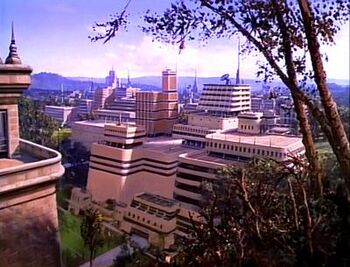 | ||
The planet is teeming with life, including the Skorr, The forest floor becomes a dangerous hunting ground at night, when feral Nur'recks and other predators stalk the wilderness for prey.
Sentient
Skoria is home to the Skorr.
The Skorr civilization has flourished for thousands of years prior to the Clan Wars. The fall of the Pre-Alar Skorr civilization began when a comet streaked through Skoria's skies. Their Current planetary Government is called the Skorr Hierarchy. They call the City of Siradran their capital.
With tensions between the various Clans already high as a result of airspace and resource disputes, the leaders of the very superstitious Clans, took the comet's arrival as a sign from the Gods that they would be victorious in their battles. As a result, violence rocked the population. Marked by the wholesale slaughter of entire bloodlines, the nine major clans began fighting bloody battles. Each claimed that the comet had spoken to them, and claimed to be its instrument on Skoria.
In about the 4th century AD, the Skorr emerged from their violent tendencies and civil wars under a philosopher named Alar, who advocated the suppressing of mysticism and Religion for organized Martial Ritual. This period was known as the Great Reformation, and much of present-day Skorr philosophy emerged from this period. The Great Reformation, caused many wars and conflicts to occur amongst various Skorr tribes; those who supported Alar's cause would become separated from friends and even close family members who did not. For cases in which parents were separated by this, a ritual was created called the Alar'kuna, a battle to determine which parent would maintain their child. Despite the acceptance of Alar's teachings, generations of imperfect copies of his writings, combined with changes in the Skorr language over time, resulted in a diluted form of the culture he instituted. Only the act of impressing his memories into the Soul of Skorr, brought clarity and direction to his descendants who eventually triumphed over their opponents and established the first and, so far, only Planetary Government.
Alar's views and lifestyle were not universally accepted by Skorr society. One particular group of Skorr who called themselves "Those who fly on Raptor's wings" were so adamant in their opposition against Alar that it lead to a nuclear war. After time the portion of Skorr society who rejected Alar's teachings left the planet for the stars. This migration of Skorr separatists would eventually become known as the Aurelians. Knowledge of the common ancestry of Aurelians and Skorr would obscure into myth over the millennium, and while some Skorr had direct dealings with Aurelians in the 22nd century, the common ancestry would not become widely accepted as fact until the mid-23rd century.
It is believed that the leader of the Skorr-Aurelians migration was a close follower of Alar's named Sabdar. Sabdar would see the founding of the Aurelian Empire, but was killed by political factions shortly thereafter.
The Skorr did recover from the effects of barbarism and turn much of their attention to space travel for several hundred years years. What would later become known as the Skorr Royal Navy was formed to orchestrate space exploration, but it ended up evolving into the Military Branch of the Skorr government, when the Skorr made contact with the Romulans, Orions and the Federation. None of the first contacts between the Skorr and these other galactic powers were without incident, and the Skorr found themselves fighting wars with both the Orion Syndicate as well as the Romulan Star Empire. There were only minor skirmishes between the United Federation of Planets and the Skorr Hierarchy.
An uneasy peace was established between the Romulans and their two war hungry neighbors. Peace and an eventual Limited Military Alliance was established between the UFP and the Skorr Hierarchy.
Nonsentient
| Skoria eclipsing Skor IV | ||
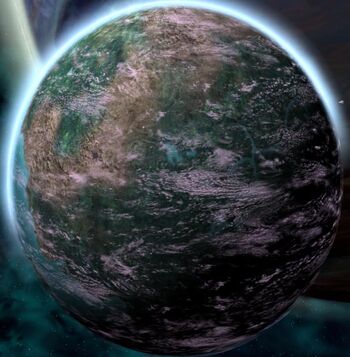 | ||
The following are just some of the indigenous creatures that make up Skoria's wildlife:
- Shuri - The Shuri is a species of bird native to Skoria. Known for their wide variety of calls and mimicry, Shuri are inquisitive creatures. They were small red birds with sharp beaks which they used to build nests, laying several eggs at a time. Both parents care for helpless chicks. Common prey of the other animals on Skoria, Shuri build nests high above ground or in hard to reach places.
- Nur'reck - The Nur'reck is a horned predator native to the forests of Skoria. Nur'recks stand on four powerful, clawed feet and have striped fur. The carnivore has two large, tusk-like fangs protruding from its upper jaw, though some are known to have four. Aggressive and graceful, Nur'recks chase down their prey then impaled them on their tusks. Though most Nur'recks hunt in the forests, some were known to prowl the deserts and hilltops of Skoria. Baby Nur'recks are known to have been tamed by intrepid adventurers during the time of the Clan Wars. The Mythological Skorr Warrior Trennar was said to have work a Nur'reck Skull as a sign of his courage and fighting prowess.
- Orrina - The Orrina is a vicious wolf-like canine predator found on the Skoria, the creature also has tiger-like characteristics. Orrina naturally travel in packs, and are particularly active during the winter months. A group of these creatures is said to have raised the Mystical Skorr warrior Mayasha after she was separated from her mother. Mayasha was said to have the ability to command the Orrina in battle. It is said that her War Pack was so stealthy that it once killed1,000 enemy Skorr warriors in the dead of night.
- Zogo - The Zogo was a large flying creature with incandescent tail feathers. It lived in shimmering nests high in the trees of Skoria's forest. The Zogo 's tail feathers were used by Ancient Skorr for medicinal potions. These avians were often eaten by as a way to improve night vision by the ancient Skorr who considered them to be magical.
- Velar - Velar are small plains land creatures from the planet Skoria. They have short fur that varies in color from brown to white. Velar have spherical heads with large, bulbous eyes and thin probosces. The creatures live in the borrows and travel both by flying or leaping. They possess flaps of skin between their forelimbs and hind limbs, allowing them to fly or glide for short distances. Velar are wily and nimble creatures, and many Skorr enjoy hunting them.
- Ucor - The Ucor is an eight-tentacled plant-like predator native to the desert and forests of Skoria. They can grow up to 6 meters tall, and 14 meters long including their 6 meter long tentacles. They are mobile and prowl the forest floor, and reach into the lower tree branches in search of Skorr and other tender morsels. It was surprisingly quick for a plant creature of its size, moving with stealth and silence. It practically glides along on its serpentine body, undulating across the forest floor like a gargantuan snake. If it finds prey in a tree it bashes its limbs against the trunk while reaching for the prey in order to dislodge them. Four of its tentacles are located on each side of its body, and it will attack as many targets as it can at once. If it injurs its prey enough to incapacitate them, it will drag the victim into its maw and consume them.
- Ongol -The Ongol, also known as the Yongol, was a large arachnid native to Skoria that got its name from a sound it makes while intimidating and attacking it's prey. It makes this sound while standing on its rear legs and encompassing its prey with all of its legs. Unlike most spiders, the Ongol actively hunts its prey instead of capturing them in webbing. It can usually be found in desert caves or scavenging the rotten meat left by a scavenger.
- Ag'ger- Ag'gers are cute, fluffy rodents native to Skoria. They live in the planet grassy plains (yellow-furred) or high in the trees (greenish white-furred), eating nuts and berries and hibernating in the winter. They have sharp front incisors and suction-like foot pads among their adaptations. Ag'gers are favored prey of Ucors. Domestic Ag'gers are kept as pets by wealthy Skorr and usually have white fur.
- Empor - Empors are forest dwelling amphibians native to Skoria. Empors were known for using their furry lure-like tongues to draw their prey toward their hidden jaws. Food is always abundant on Skoria and Empors usually eat rodents, birds and other small creatures. Empors have pale fleshy skin covered with mucous, which allows them to slither into tight spots and then strike prey fast after luring them in close with its tongue. Even though its primary means of locomotion is slithering it still has claws for anchoring itself to the ground or wherever it was hiding. Empors have excellent eyesight due to multiple eyes on its head.